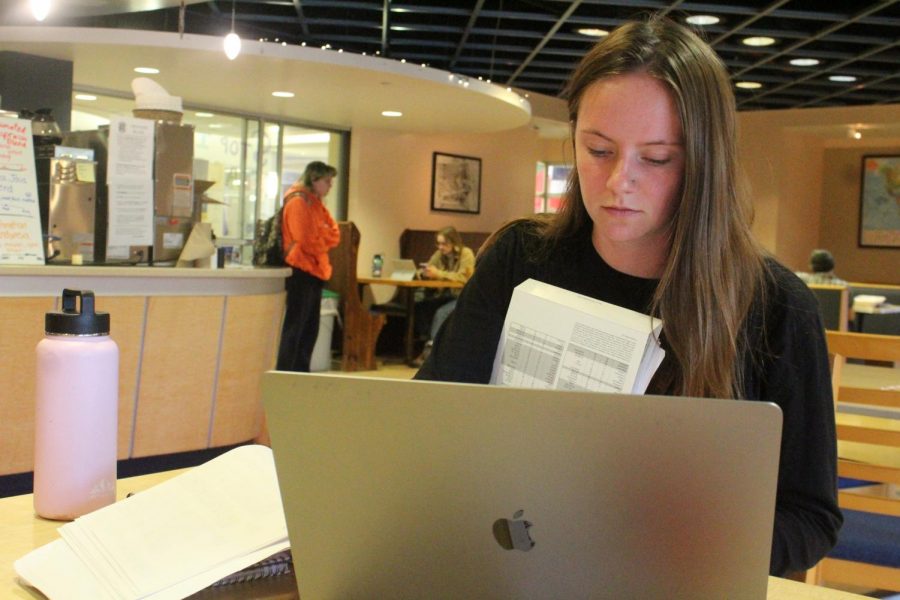College to replace some Wi-Fi infrastructure
ASG, LITS work to identify internet outages
Nelly Stafford, ’25, works in Grounds for Change. Stafford is one of many students who have experienced internet issues on campus.
From dormitories to dining halls, the invisible threads that connect students to professors, online research and the globe are faltering. Davis Piazza, ’23, lives in North Village II, and has routinely had issues with his Wi-Fi connection.
“It’s not that it’s bad when it’s working, it’s that it doesn’t work all the time,” Piazza said.
These outages, which Piazza expects every afternoon, can last for several hours.
“At best it’s usually an hour, but at worst it’s been an entire afternoon and then into the next day,” Piazza said. “I remember it went off at about three (p.m.) and then we didn’t get it back until two (p.m.) the next day.”
Piazza is not alone: some of the classes he is in have collectively missed assignments due to the outages.
“One of my professors was very surprised when we said that we all lost internet,” Piazza said. “For one specific assignment — a lot of us are juniors living in NVII — (that assignment) wasn’t done.”
Both the Allegheny Student Government and the college administration are working on mitigating and solving the issue.
“It does seem to be a widespread issue across campus, specifically in dorm buildings and academic buildings,” said ASG Director of Student Affairs Elizabeth Graham, ‘22. “I work in (the) Financial Aid (Office) and it’s dropped out in the (454 House) a number of times.”
At the scale of Allegheny’s network, Interim Chief Information Officer William Anderson said that two issues typically arise: either the network does not have enough bandwidth to handle all the users on the network at a given time, or the physical infrastructure behind the network starts to deteriorate to the point where the connection starts to drop.
“Students have been incredibly helpful when questions about service have been reported,” Anderson said. “It’s very important for us to know where and when and what the device being used was, what the application being used was. Those things all play into how we need to respond to questions like that.”
There are two ways for students to notify college authorities about Wi-Fi struggles: through a Web Help Ticket submitted to Library and Informational Technology Services or through a Google Form operated by ASG. Graham said that the Google form was born of some of the faults of the LITS system.
“Unfortunately, if you put the ticket in through the desk, a lot of times you’re outsourced to the actual Wi-Fi company, rather than the school, which takes a prolonged period of time,” Graham said. “Our hope is that by getting the specific location, the specific time and even what product you’re on — computer, tablet, phone — the school can report more accurate information, and therefore, the company can target those areas better.”
Anderson, however, recommended that students use the LITS process to keep information in the same place.
“We’re happy to get information no matter how we get it,” Anderson said. “It’s just easier if it’s consolidated and from the same source.”
Prior to the 2020-21 academic year, the college updated some but not all of the wireless infrastructure in anticipation of the bandwidth required to support widespread virtual instruction.
“Two key pieces of equipment called ‘controllers’ were upgraded, and that allowed for newer wireless access points to be installed,” Anderson said.
“Controllers” are pieces of equipment that manage multiple “access points” — the blinking rectangular boxes that dot classrooms and buildings across campus. But they are far from the only pieces of equipment on campus, and the school plans to completely overhaul the entire system in the long-term.
“We just had a contract signed to replace the whole fiber-optic plant on campus,” Anderson said. “That’s something that’s hard to do with students in residence halls and buildings constantly being occupied and used. That work will probably begin next summer.”
Beyond the fiber-optic backbone, Andersen said that proposals for replacing the entire infrastructure are still in the works, though his team is shooting for Cabinet and Trustee approval by the end of this semester. However, the cost of such a project is still up in the air, though ASG has indicated they are willing to help given the importance of the issue.
“Cost-wise, we have been told that it would be a big thing,” Graham said. “I feel (that) I can speak for (ASG President) Noah (Tart, ’22), and (Vice President) Sophie (Adams, ’22), that we do feel as though this is a pertinent issue, considering how much students rely on the WiFi here.”
Anderson could not set a dollar amount to the plan, given that much of the renovation plan is still undecided.
“It’s not inexpensive, I’ll tell you that,” Anderson said. “We’re looking at proposals that hopefully control that cost as well as it can be controlled, and also spread the cost over the life of the equipment so that it’s not one big check upfront, it’s several smaller checks over the years in which the equipment’s useful. It’ll have an impact, no question about it.”
Ultimately, Graham said the objective is to have a network students can rely on.
“The broad goal is to get a WiFi network that’s not shutting off for students once a day,” Graham said. “Part of my job on ASG is to take the feedback from the Student Life survey sent out every year and implement that. One of the biggest consensus as a whole is issues with Wi-Fi.”
For Piazza that reliability can’t come soon enough.
“I don’t mind having slow internet as long as I can consistently have internet,” Piazza said. “The inconsistency has been a real problem for me.”
Editor’s Note: a previous version of the headline for this story read, “College to replace Wi-Fi infrastructure.” The headline has been updated to, “College to replace some Wi-Fi infrastructure” to reflect that the college has not yet committed to replacing the entire internet infrastructure.

Sami Mirza is a senior from many different places. He is majoring in International Studies with a focus on the Middle East and North Africa and minor in...









